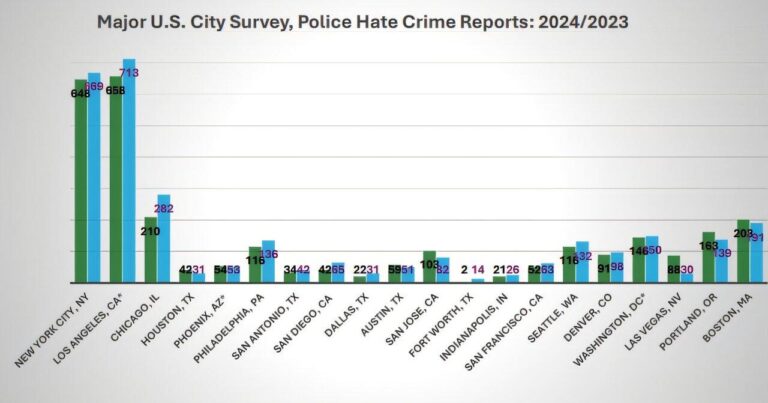Hate crimes in major U.S. cities have reportedly declined in 2024, marking a shift in a troubling trend that has long concerned communities and law enforcement alike. However, experts caution that the raw numbers may not fully capture the complex realities behind these statistics. While preliminary data suggests a drop in incidents, questions remain about underreporting, changing definitions, and the broader social dynamics at play. This article examines the recent figures, explores the nuances behind the numbers, and considers what they truly mean for efforts to combat hate-driven violence across the country.
Hate Crimes Show Decline in Major US Cities Amid Continued Community Concerns
Recent FBI and local law enforcement reports indicate a noticeable drop in hate crime incidents across several major U.S. cities in the first half of 2024. Cities like New York, Chicago, and Los Angeles reported decreases ranging from 8% to 15% compared to the previous year. Officials attribute this trend to enhanced community policing efforts, better reporting systems, and targeted outreach programs aimed at vulnerable populations.
Despite this progress, activists and community leaders caution against interpreting the data as a sign of safety or resolution. Several underlying issues persist:
- Underreporting: Many victims remain reluctant to come forward due to fear of retaliation or lack of trust in authorities.
- Emerging Online Hate: Cyberhate and extremist rhetoric continue to surge on social media platforms, threatening to spark real-world violence.
- Localized Hotspots: Certain neighborhoods still experience disproportionate rates of hate incidents that are not always captured in citywide statistics.
| City | 2023 Incidents | 2024 Incidents (est.) | % Change |
|---|---|---|---|
| New York | 175 | 160 | -8.6% |
| Chicago | 120 | 102 | -15.0% |
| Los Angeles | 98 | 90 | -8.2% |
Challenges in Data Collection Reveal Gaps in Understanding Hate Crime Trends
Despite the apparent decline in reported hate crimes, experts warn that limitations in data collection methods obscure the true picture. Reporting inconsistencies across jurisdictions, varying definitions of hate crimes, and underreporting by victims contribute to significant gaps in nationwide statistics. Many law enforcement agencies lack the necessary training and resources to accurately classify and document hate incidents, leading to potential misrepresentation of trends. These challenges highlight the crucial need for standardized protocols and improved transparency to better understand the scope and dynamics of hate-motivated offenses.
- Inconsistent Reporting Standards: Diverse classification criteria complicate cross-agency data aggregation.
- Victim Reluctance: Fear of retaliation or distrust in law enforcement discourages reporting.
- Resource Constraints: Limited personnel and training hinder thorough hate crime documentation.
| Factor Affecting Data | Impact | Potential Solution |
|---|---|---|
| Varied Definitions | Inconsistent trend interpretations | Unified federal guidelines |
| Underreporting | Skewed crime prevalence | Community outreach programs |
| Training Gaps | Erroneous data entry | Mandatory law enforcement training |
Experts Warn Against Complacency Despite Reported Drops in Incidents
Despite the encouraging statistics showing a decline in hate crime reports across major U.S. cities in 2024, experts emphasize that this should not lead to a false sense of security. Several factors contribute to concerns over the reliability and completeness of the current data. Underreporting remains a significant issue, as victims may fear retaliation or distrust law enforcement agencies, potentially skewing official figures downward. Additionally, the evolving nature of hate crimes, particularly with the rise of online harassment and digital threats, complicates traditional tracking methods.
Experts highlight several critical points for consideration:
- Improved training and resources for local law enforcement to identify and respond to hate crimes more effectively.
- Greater community engagement to encourage reporting and support victims.
- Enhanced data collection that includes new forms of hate-driven offenses, especially on digital platforms.
- Recognition of regional disparities that may mask increases in specific areas despite overall declines.
| City | Reported Hate Crimes 2023 | Reported Hate Crimes 2024 | Expert Concern Level |
|---|---|---|---|
| New York | 350 | 320 | Moderate |
| Los Angeles | 280 | 250 | High |
| Chicago | 220 | 190 | Moderate |
| Houston | 150 | 140 | Low |
Calls for Improved Reporting Systems and Enhanced Community Outreach Initiatives
Advocates and experts emphasize the urgent need to upgrade current hate crime reporting mechanisms across major U.S. cities. Despite the reported decline in numbers, many incidents remain unreported due to mistrust, fear of retaliation, or lack of accessible reporting channels. Organizations, law enforcement agencies, and community leaders alike are pushing for:
- Implementation of user-friendly digital platforms for anonymous reporting
- Standardized training for local police on identifying and documenting hate crimes
- Collaboration with community-based groups to improve data accuracy
- Regular public updates to foster transparency and trust
Alongside these system improvements, community outreach programs play a pivotal role in bridging the gap between authorities and vulnerable populations. Experts argue that enhanced education and awareness campaigns can dramatically increase reporting rates by:
- Building cultural competency among law enforcement
- Offering multilingual resources and support services
- Engaging grassroots organizations to facilitate open dialogue
- Promoting community resilience and solidarity
| Initiative | Expected Impact | Timeline |
|---|---|---|
| Digital Reporting App | Increase anonymous reports by 40% | Q3 2024 |
| Law Enforcement Training | Improve hate crime data accuracy | Ongoing |
| Community Workshops | Enhance trust & awareness | Biannual |
Concluding Remarks
While preliminary data indicates a decline in reported hate crimes across major U.S. cities in 2024, experts caution that these numbers may not capture the full scope of the issue. Underreporting, variations in classification, and ongoing social tensions suggest a complex reality behind the statistics. As communities and law enforcement grapple with hate-motivated violence, a deeper analysis and continued vigilance remain essential to understand and address the root causes beyond the apparent drop in figures.




